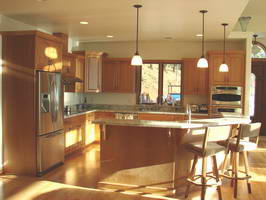Installing a Ceiling Fan in a Bathroom
 '; ';
|
How to Plan and Install a Ceiling Fan in an Older Home: I am trying to install a ceiling fan in a bathroom, the house was built in 1922. I am not positive how old the wiring is that I am finding up there but it is old. © By: Dave Rongey |
Guide to Installing a Bathroom Ceiling Fan in an Older Home
Electrical Project: I am trying to install a ceiling fan in a bathroom, the house was built in 1922. I am not positive how old the wiring is that I am finding up there but it is old.
- There was an existing ceiling light fixture there originally. The light originally burned out and in the process of replacing the light bulb my boyfriend broke the bulb as he had been changing the bulb himself for at least the last 35 years.
- I went ahead and started work with the power off, to take down the light and install the fan I had previously bought for that light. Yes, I have myself changed lights in previous homes into ceiling fans with lights. 5 in the last few months while working on a house renovation on one of our own houses.
- I was advised not to connect the existing old wires with new conductor wires, but to replace all of it.
- I am unsure of how I am to reach all of it, where to start even. I have talked to numerous electricians about all my questions and I don’t feel sure of exactly how to do this. One asked if there was a basement and he said there should be a box down there to connect to. I am not seeing that.
- I want to know exactly what to do and look for before I start anything. Also which is confusing is there are 3 black wires and 3 white wires, It has always been a two wire job.
- I was told to combine all three black together and combine all 3 white together, also two white and two black incoming to the light don’t seem to have any power in them as I tested with an electrical tester. What is up with that?
- I have a lot of expert quality books that I have been scouring and I don’t see the answers I need. I am hoping you can tell me what if anything yet I am doing right. I won’t take any further steps until I know exactly what to deal with this weird situation.
I will be waiting on your expert advice before touching anything.
Please help. Thank you.
Vickie
This electrical question came from: Vickie, from Piqua, Ohio.
Dave’s Reply:
Thanks for your electrical question Vickie.
The Basics of Installing a Ceiling Fan
Plan and Install a Ceiling Fan in an Older Home
- This is a very detailed question, but I believe that if we go back to the basic requirements for installing a ceiling fan in most any location then the installation will be correct.
- When a ceiling fan is installed in a home with older electrical wiring then the wiring must be identified in order to make the correct connections and switch wiring and terminations.
- It is always best to update the electrical wiring, and this could be a good starting place, however a project of upgrading older home wiring must be well planned out.
- Be sure to install an approved electrical box for the ceiling fan that is securely installed and supported.
How to Install Ceiling Fans
Take the mystery out of ceiling fan wiring. Ceiling Fans are a great way to lower your energy bill and brighten up one of your favorite rooms.
-
How to Install Ceiling Fan Wiring
- Step-by-step pictures – Easy wiring diagrams and installation guide – Light and fan switch variations.
- Home Electrical Junction Boxes
Electrical Junction Boxes for Home Wiring
Understanding electrical junction boxes and what they are used for. Home electrical wiring is the process of installing electrical wire to a location that will serve electrical devices or an appliance. One very important component is the box where the wire will be installed. The type and size of the home wiring electrical boxes will depend upon the circuit size, application and its location.
The following may also be helpful for you:
Be Careful and Be Safe - Never Work on Energized Circuits!
Consult your Local Building Department about Permits and Inspections for all Electric Wiring Projects.
More articles about Ceiling Fans, Electrical Wiring and Home Electrical Wiring: |
|
| « Previous | Next » |
Troubleshooting a Door Bell Chime |
Sub Meter to Track Energy Usage |













